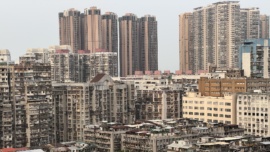China wants to improve interconnectivity at the Guangdong-Hong Kong-Macau Greater bay Area (GBA). One of the biggest beneficiaries will be Macau, which still needs better access.
MB November 2020 Special Report | Getting in and out
Much more than a political, social, or an economic concept, GBA is, at present, a challenge of interconnectivity and construction of transport infrastructure.
When the network of motorways, trains and airports is ready in 10 years, GBA will then be able to evolve into other, with political and social dimensions, as if preparing the end of the periods foreseen in the joint declarations of Hong Kong and Macau.
Until then, there is much to build in order to link the 11 cities in Guangdong province, an example being the 775 kilometers of several urban railway projects worth RMB 474.1 billion. Or the planned cluster of airports, outlined by the Civil Aviation Administration of China and stressed the need to coordinate air travel development efforts between the places covered by the GBA initiative.

Yet much is already done.
As a study of Chinese Geographical Science (2019) shows, “transport accessibility within the Guangdong-Hong Kong-Macau GBA costs ‘one hour’ and the spatial distribution of accessibility in the area presents clear ‘core-periphery’ spatial characteristics, with Guangzhou, Foshan, Shenzhen constituting the core.”
The findings of this research clearly state that “the transport accessibility of Guangdong-Hong Kong-Macau is high. Average accessibility of urban nodes as measured by travel time is 0.99 h, and the areas accessible within 1.42 h occupy 79.14 per cent of the total area.”
The study found that “most of the areas with the lowest accessibility are found in the peripheral area, with the worst accessibility being 4.73 h. Compared with the west-side cities, the economically developed east-side cities of the Guangdong-Hong Kong-Macau GBA have higher connectivity with roads, railways, ports, and aviation transport. Guangzhou, Foshan, Zhuhai, Shenzhen, Hong Kong and Macau are closely linked. The higher the accessibility, the closer the intercity connectedness.”
However, another international research (Changing Connectivities of Chinese Cities in the World City Network, 2010–2016) concluded that “with the exception of Hong Kong, Macau, and Kaohsiung of Taiwan, all Chinese cities record connectivity gains.”
China is not satisfied with what already exists, as can be seen. Because, as the sinologist Jean Berlie argues, “the major function of the GBA is to expand the role of Hong Kong, Macau, and the Province of Guangdong to develop the Belt and Road Initiative.”
And if the different studies tend to forget the differences between Macau and Hong Kong, the situation in terms of accessibility in the two specific regions is quite different.
This was warned last year by the director of the Department of International Development of the Institute of World Economics and Politics of the Chinese Academy of Social Sciences.
Xu Qiyuan wrote an article “China Daily” explaining that “the full integration of Macau in the GBA depends on a series of changes” that he considers necessary and that in order to integrate into the country’s development plan “Macau has to respond to several major challenges.”
Xu Qiyuan argued that Macau needs to optimize the road and rail transit system in a way “to promote better interconnection between the various modes of transport and, in particular, flights between nearby regions,” suggesting the possibility of connecting the high-speed train. Nanning-Shenzhen speedway to Macau, so that the MSAR is integrated into the mainland high-speed train network.
The problem is not solved only with money and projects.
As Professor José C. Alves, Dean of the Faculty of Business at City University of Macau, defends to Macau Business, “development without increased regional mobility and integration in regional networks is not likely to happen. However, mobility is not the only factor. There must also be people prepared to execute that vision.”

In terms of accessibility, the next 10 years are crucial for Macau, not least because, as several scholars opine, Xi Jinping’s “China Dream” seems to be taking a political shape through China’s infrastructure connectivity projects.
“Indeed, infrastructure is now China’s new tool for nationalism,” state the two authors of Taiwan, Hong Kong, and Macau in China’s infrastructure-diplomacy and the China Dream: Will the dominions fall? “China is moving at lightning speed to create global-scale infrastructure and connectivity projects,” the paper reads.
“Mobility is not the only factor. There must also be people prepared to execute that vision” – José Alves

Benefits for Macau
A more complete and diversified network of accessibility to Macau will improve the lives of residents, defends the Chairman of the Council of The Chartered Institute of Logistics and Transport in Macau.
“The problems of transportation in Macau are mainly attributed to its own urban spatial characteristics (small and high dense urban area), historical factors (bus route planning, urban planning, legal issues, etc.), and travel habits (e.g. excessive dependence on private transportation),” states Ku Weng Keong to Macau Business.
As Mr Ku explains, currently the Barrier Gate carries a good portion of visitors to and from Macau, “which generates a tremendous amount of road traffic pressure. With the development of regional land transportation infrastructure in the GBA accelerating, especially the possibility of Macau joining the regional high-speed rail network via Hengqin, coupled with the developments of LRT network in Macau, the current distribution of visitors to access Macau may change.”
Ku Weng Keong gives another example: if a certain degree of visitors destined to COTAI chooses to access Macau via Hengqin, which is forecasted to support up to around 220,000 persons a day, the pressure on the Barrier Gate area will be reduced, and also help to relieve the internal transportation problems in Macau.
























